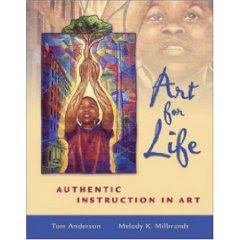- Are active and easily excited; use almost any topic as motivation
- Enjoy working with their hands
- Take great pride in their work
- Exhibit strong feelings of possessiveness
- Are eager to learn, do not underteach
- Want to be first; assign special responsibilities
- Have a limited attention span and are easily fatigued; give a series of objectives throughout lesson rather than all at the beginning
- Have feelings that are easily hurt; praise when students arrive at their “own way”
- Are alternately cooperative and uncooperative
- Usually can grasp only one idea at a time
- Delight in imaginative games, dances, stories, and plays; like to pretend and engage in make-believe
- Desire the approval of classmates and teachers
- Enjoy fantasy; use fantasy as motivation
- Are interested in new things to touch and taste; use tactile motivations
- Are fascinated by moving and mechanical devices
- Enjoy TV, illustrated books, movies, picnics, school field trips, new clothes, and pets
ARTISTIC DEVELOPMENT
Shapes
Five- and six-year-olds will typically:
- Draw the geometric symbols of the circle, square, triangle, oval, and rectangle
- Employ a basic symbol, such as a circle, to depict varied visual images-the sun, a head, a table, a flower blossom, a tree, a body, a room
- Use combinations of symbols that differ from those their classmates use
- Depict simplified representations and are not too concerned with details
Some six-year-olds and most seven-year-olds typically:
- Change slowly from geometric, symbolic interpretations to more specific characterization and delineation
- Use more details in their depictions
Size
Five- and six-year-olds typically:
- Use emotional exaggeration of size, enlarging things that are important to them and omitting features that are not
Some six-year-olds and most seven-year-olds typically:
- Approximate more representative proportions
Color
Five- and six-year-olds typically:
- Use color in a personal or emotional context without regard to its identity
Some six-year-olds and most seven-year-olds typically:
- Use color in a local, stereotypical way
Space
Five- and six-year-olds typically:
- Employ a baseline as a foundation
- Draw both the inside and outside of an object
Some six-year-olds and most seven-year-olds typically:
- Begin to place distant objects higher on the page, although objects are often drawn the same size
- Use a foldover technique, turning their papers completely around as they draw
Objects
Five- and six-year-olds typically:
- Draw things intuitively as they know them
Some six-year-olds and most seven-year-olds typically:
- Draw objects as they know them to be rather than how they see them at the moments
The Human Figure
Five- and six-year-olds typically:
- Devise a variety of interpretations or schemata depending on their experience
Some six-year-olds and most seven-year-olds typically:
- Begin to use apparel and detail to distinguish sexes
TEACHING ART
Teaching Drawing
- Discourage from rushing to finish by scribbling backgrounds haphazardly
- Like to use their pictures to tell stories
- Introduce students to various tools for making linear images
- Praise their discovery of various line patterns
- Will use fold-over and x-ray drawing
- Introduce to line drawing, shades and value, color, and pattern
- Provide opportunity to draw real objects
- Encourage to fill the page
Teaching Cutting, Pasting, and Collage
- Need to develop scissor skills
- Provide left-handed scissors
- Demonstrate how to use glue economically
- Provide opportunities to paste little shapes onto large shapes
Teaching Printmaking
- Can be made with vegetables, found objects, clay pieces, erasures, cellulose scraps, or hands and fingers
Teaching Ceramics
- Each student should have a clay ball about the size of a grapefruit
- Encourage students to squeeze, pinch, poke, and stretch clay
- Teach them how to make coils and balls
- Encourage students to hold clay while they work with it
- Can create simple sculptural forms, such as animals
- Can make simple pinch pots
ART CRITICISM, ART HISTORY, AND AESTHETICS
- They can begin to develop a language for art criticism, with the manes of the formal elements
- Expose students to as much material as possible to establish knowledge base to (1) teach students how to experience the delight and values shown in the arts and (2) to contribute to the students’ general perceptual and conceptual knowledge
- Children at this age like pictures that clear and vivid
Children between ages 5 and 7 should know the following basic art terms:
- Black
- Blue
- Bright
- Brown
- Brush
- Cardboard
- Chalk
- Circle
- Clay
- Coil
- Construction paper
- Crayon
- Bark
- Dot
- Drawing
- Easel
- Eraser
- Fingerpaint
- Glue
- Green
- Grey
- Hammer
- Ink
- Kiln
- Light
- Manila paper
- Mural
- Nail
- Newsprint paper
- Orange
- Oval
- Overlap
- Paste
- Pastel
- Pen
- Pencil
- Pink
- Pinch pot
- Purple or violet
- Rectangle
- Red
- Ruler
- Scribble
- Shape
- Square
- Stripe
- Tempera paint
- Tissue paper
- Triangle
- Watercolor
- Weaving
- White
- Yellow
Suggested Subjects or Themes for First- and Second-Graders
- Playground games
- Fun in the snow
- Fun in the fall leaves
- A flower garden with insects
- My pet and me
- Stuffed animals
- Animals in the zoo or jungle
- Farm animals
- Noah’s ark
- Kings and queens
- What I like to do when it rains
- What my parents and I like to do together
- My make-believe wish
- Skipping rope
- Our community helpers
- Butterflies in a garden
- Fish in the sea
- Land of make-believe
- My favorite toy
- Clowns











